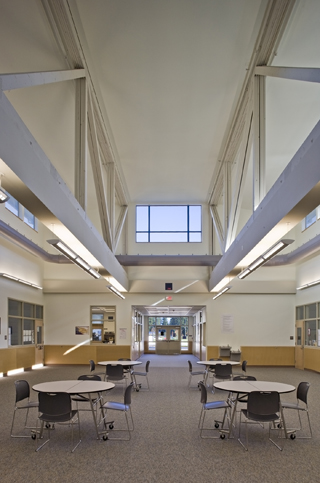|
Subscribe / Renew |
|
|
Contact Us |
|
| ► Subscribe to our Free Weekly Newsletter | |
| home | Welcome, sign in or click here to subscribe. | login |
Construction
| |
 |
August 23, 2012
Portables aren’t the last word in modular schools
Studio Meng Strazzara

Erwood
|
Construction costs are starting to rise once again. With the realities of shrinking capital budgets and increasing demand for new instructional spaces, educational providers need to consider a wide variety of options when creating new facilities.
This is particularly true for alternative and choice schools that a school district may build without the benefit of state construction funding. For many educational providers, the design and construction of a modular school can be a sustainable and cost-effective option.
We are all familiar with one type of modular construction: portable classrooms. Chances are you have personally taken a class or two in a “portable.”
Portable classrooms provide school districts with the flexibility to balance classroom needs with changing school populations and programs. They also may supply space for use by the community.
However, for various reasons, portable classrooms are not always viewed favorably. They tend to be located apart from the main school buildings, frequently behind the school in an area that was previously used for play, athletics or parking. Many of them are viewed as plain or less attractive than a traditional school building.
And while the state Office of Superintendent of Public Instruction’s school construction assistance program recognizes traditional site-built school square footage in its formula for determining funding for school districts, it does not consider portable classroom space.
So why might a school district consider modular construction?
• There may be cost savings. Frequently the cost for factory-built schools is less than for traditional site-built schools. This is particularly true when the building module sizes are close to those used for standard classroom portables. To achieve the most cost-effective results, it is important that each module is designed taking into account factory-construction practices and transport limitations.
• The construction duration is shorter. This can be the greatest selling point for modular construction. Even a large modular project can have significant time savings.
For the Marysville School District’s Marysville Tulalip Campus, we designed 73,000 square feet of modular construction supplied by Williams Scotsman in four buildings, and a 12,000-square-foot conventionally constructed gymnasium.
There are over 200 modules in the project. The modular buildings house administration, Arts & Technology High School, Heritage High School and 10th Street Middle School.
To illustrate how quickly the campus came together, the modules for the 39,000-square-foot Arts & Technology High School were started in the factory in April prior to the completion of the land-use permitting process. The clearing and grading on the 20-acre forested site commenced in June, and students and teachers were in classes in December.
This would not have been possible with conventional construction. The remaining campus buildings were completed by the following spring.
For Lake Washington School District’s Northstar Middle School, we created a 95-student campus of four modular buildings. They were supplied by Pacific Mobile and based on a standard double-classroom footprint and custom designed to accommodate the school’s specific programs. The site work was started this past June and the school will open this September.
• There are multiple options for project delivery. In a typical modular project, the design team will take the project from education specifications through the design development phase in the same fashion as any traditional project. Following the design development phase, the buildings can be purchased directly from a modular building supplier through a public purchasing cooperative such as KCDA or put out for bid.
The construction documents for the buildings are produced as shop drawings by the modular building manufacturer, and the design team prepares the site development drawings. The design team reviews the modular shop drawings and product submittals before construction of the units start. The result of this process tends to be a reduction in change orders.
• Modular buildings are green. Modular buildings can meet the requirements of the Washington Sustainable Schools Protocol and achieve LEED certification.
What really makes factory-built construction green is the reduction in construction waste. Factories order materials in optimal sizes that reduce the need for cutting and modification, and they have the ability to store and later use cut pieces that would otherwise be wasted materials — a process not as readily feasible on a traditional job site.
While there is the delivery of materials to the factory and transport of the modules to the project site, the overall environmental impact of vehicular traffic is reduced for most projects.
• There is less disruption to the site. Due to the reduction in construction duration, most of the site work can be done in months when we have favorable weather.
This reduces the stormwater construction requirements. Contractor laydown area on the site is dramatically reduced, resulting in a smaller overall impacted area.
This was a primary consideration for our design of the Kirkland Children’s School environmental education center. The school wanted to expand but needed to keep the school in operation during construction, and had little space for contractor staging.
We designed a highly customized modular facility with a green walkway that offers access to outdoor classroom learning environments, nature exploration, peaceful classroom views, and open land for vegetable gardens.
• The impact to neighbors is reduced. This is a major benefit from the shortened time on site. Fewer days of construction noise, dust, traffic and construction worker parking leads to happier neighbors.
Modular schools can be designed to be aesthetically beautiful and functionally modern. They can be designed to fit a neighborhood or campus aesthetic.
Setting the buildings on permanent foundations with their floor levels at grade results in a finished condition that is similar to conventional construction and eliminates the need for ramps.
Additionally, the buildings can be clad with any siding or roofing used in traditional buildings. Flexible, adaptable, light-filled classrooms and shared learning spaces can be included in the design.
Each school at the Marysville Tulalip Campus has flexible classrooms, commons spaces and shared learning areas with 25-foot-high ceilings and clerestory windows — all completed with modular construction.
Modular construction may not be appropriate for all schools, but it does offer options to school districts seeking creative ways to build sustainable and economical 21st-century educational environments.
Dennis Erwood is a principal at Studio Meng Strazzara, which has designed modular school campuses for the Snoqualmie Valley, Marysville and Lake Washington school districts.
Other Stories:
- 5 tips to help districts with their long-range plans
- School contractors face new scrutiny from taxpayers
- UW’s Mercer Court aims to keep students socially connected
- Skills centers making inroads in Washington
- Schools can stretch facilities budgets by embracing technology
- Laser scanning: a powerful tool for school projects
- Schools face pressure to keep up with tech trends
- Online learning will have lasting effect on campus spaces



